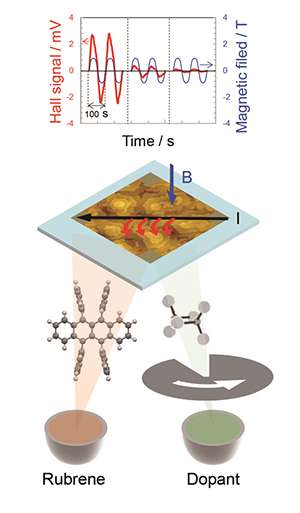Dawn of organic single crystal electronics

Researchers at the Institute for Molecular Science, National Institutes of Natural Sciences (Japan) have developed a method for high performance doping of organic single crystal. Furthermore, they succeeded in the Hall effect measurement of the crystal—the world's first case. The research has been published in the Advanced Materials.
Controlling "holes" and "electrons" responsible for electric conduction of p-type and n-type semiconductors by doping—adding a trace amount of impurity—had been the central technology in the 20th century's inorganic single crystal electronics represented by silicon chips, solar cells, and light emitting diodes. The number of carriers (holes and electrons) created by doping and their moving speed (mobility) can be freely evaluated by "Hall effect measurement" using a magnetic field. However, in the field of organic electronics emerging in the 21th century, no one has ever attempted to dope impurities into an organic single crystal itself nor measure its Hall effect.
"We have combined the rubrene organic single crystal growth technique with our original ultra-slow deposition technique of one billionth of a nanometer (10- 9 nm) per second, which includes a rotating shutter having aperture." explains Chika Ohashi, a PhD student, SOKENDAI in the group. "For the first time, we have succeeded in producing the 1 ppm doped organic single crystal and have detected its Hall effect signal." The doping efficiency of the organic single crystal was 24%, which is a much higher performance compared to 1% for the vacuum deposited amorphous film of the same material.
Lab head Prof. Masahiro Hiramoto sees the present results have the meaning of dawn of organic single crystal electronics similar to the silicon single crystal electronics. In future, devices such as high performance organic single crystal solar cells may be developed.
More information: Chika Ohashi et al, Hall Effect in Bulk-Doped Organic Single Crystals, Advanced Materials (2017). DOI: 10.1002/adma.201605619
Journal information: Advanced Materials
Provided by National Institutes of Natural Sciences

















